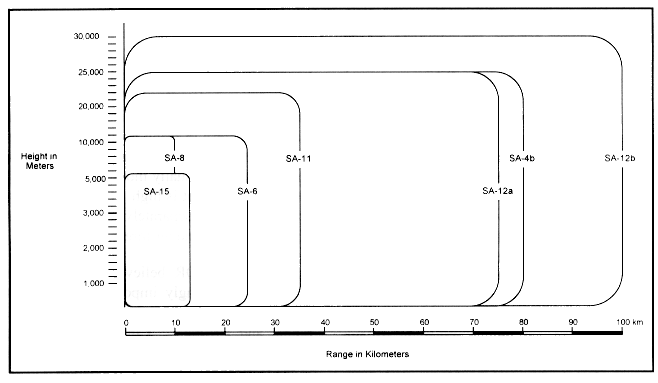The main objective of air defense is to prevent enemy air action from interfering with maneuver force operations. Air defense forces protect ground units and other potential targets from attacks by fixed-wing ground-attack aircraft, cruise missiles, and armed helicopters. Ground forces then can continue their own missions. The secondary mission of air defense troops is to protect air and airborne/heliborne missions forward of the line of contact.
Achieving surprise is fundamental to any successful air defense operation, given the potential physical destruction that can be achieved by attacking an unsuspecting and unprepared enemy. The psychological effects of violent and unexpected fires on aviation crews are often only temporary, but they can reduce the effectiveness of air crews preparing to attack at critical moments. The element of surprise is also increasingly important because of modern technological advances. The speed and evasiveness of modern aircraft reduce engagement times. Modern aircraft also have a great amount of firepower with which to suppress air defenses. These two factors make it necessary for units to achieve some degree of surprise.
When planning air defense, the commander must always consider the mobility of air defense weapons and the time required for their deployment. The ground forces, for which air defenses provide cover, are quite mobile and frequently change formation as they deploy. The air enemy is mobile, and can attack from many directions or altitudes. Therefore, the commander must use to the maximum the mobility and firepower of his assets, creating optimum groupings and fire plans.
Air defense forces must provide continuous protection of critical organizations and assets. Only constantly moving air defense units that have adequate logistics support can ensure comprehensive air coverage. They must provide air defense day or night in all weather conditions. Mobility contributes directly to continuity.
The inventory of air defense weapons includes a variety of missiles, guns, and support equipment. Air defense weapons exist at nearly every level. Radar target detection and fire control systems fall into two general categories: surveillance and fire control. Surveillance includes early warning, target-acquisition, and height-finding radars. Some fire control radars also have limited target-acquisition capability. Radars work as systems rather than as separate units.
Air defense planners at all levels integrate radars into an overall system of coverage. Army early warning battalions deploy their radars 10 km or so from the line of contact. This gives them the ability to detect medium- and high-altitude targets up to 160 km in the enemy's depth and low-flying aircraft out to 80 km. Battalions of the army-group's early warning regiment or brigade establish a second line of radar posts about 50 km behind the first to give depth.
Fire control elements turn on radars at the last minute to achieve surprise and to avoid exposing themselves to enemy electronic or physical attack (including antiradiation missiles). The air surveillance radar network is difficult to avoid or defeat. Large numbers of radars are highly mobile and can quickly displace. The wide spread of operating frequencies makes ECM difficult. Operator training stresses electronic counter-countermeasure skills and the use of radio and electronic silence where possible.
Air defense assets from army group down through division create an area defense. Radars provide an unbroken detection envelope extending well into enemy territory and across the entire zone of operations. Army group and army medium-range SAM units are probably the first to engage enemy aircraft that slip past fighters. The Russian SA-8, and SA-15 are division-level short-range SAMs; the SA-6 is a division-level medium-range SAM; the SA-11 is an army-level medium-range SAM; the SA-4 is an army- or army group-level medium-range SAM; the SA-12a and SA-12b are army group-level medium-range SAMs.
 Some trends in air defense development will become more widespread in the near future.
These include the production of authorized and unauthorized copies of existing systems and the
development of hybrid systems. The sensor package may consist of one or more radars, direct
view optics, and electro-optics systems. The sensor package is the single most important aspect
of air defense systems since these devices perform the surveillance and tracking functions. As
the data classification permits, all attempts have been made to provide the user with as much
information as possible in these areas. Radar systems have traditionally been the most popular
sensor for air-defense systems, however, with the latest generation weapons they are usually
supplemented with a variety of optic or electro-optic sensors such as; TV cameras, night vision
sights, and laser rangefinders.
Some trends in air defense development will become more widespread in the near future.
These include the production of authorized and unauthorized copies of existing systems and the
development of hybrid systems. The sensor package may consist of one or more radars, direct
view optics, and electro-optics systems. The sensor package is the single most important aspect
of air defense systems since these devices perform the surveillance and tracking functions. As
the data classification permits, all attempts have been made to provide the user with as much
information as possible in these areas. Radar systems have traditionally been the most popular
sensor for air-defense systems, however, with the latest generation weapons they are usually
supplemented with a variety of optic or electro-optic sensors such as; TV cameras, night vision
sights, and laser rangefinders.



